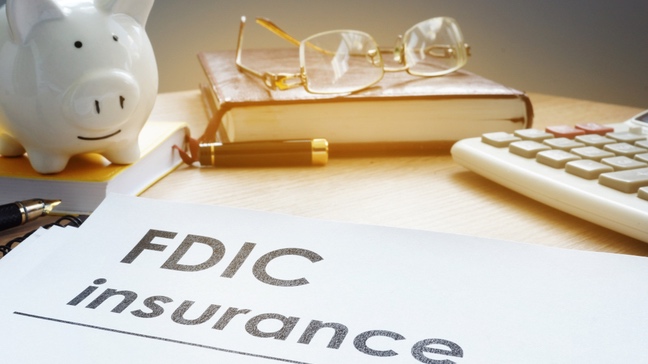Editorial Note: We earn a commission from partner links on Doughroller. Commissions do not affect our authors’ or editors’ opinions or evaluations. Learn more here.
Although rare, banks can go bankrupt. However, your money can be protected if the bank you deposited money with is federally insured by the Federal Deposit Insurance Corporation or FDIC.
Since it’s so important that your deposits are FDIC-insured (the equivalent for credit unions is NCUA, or the National Credit Union Administration, which also operates similarly), let’s take a look at exactly what it is, what it covers, and how to ensure your hard-earned money is safe.
Deal of the Day: Chase is now offering a $300 cash bonus when opening a Total Checking® Account. No minimum deposit and all deposits are FDIC-insured up to the $250,000 per depositor maximum.
What is FDIC Insurance?
In 1929, a major event called the Stock Market Crash occurred, leaving many Americans panicked. Having so many banks fail throughout the Great Depression and the other financial blunders during that era created a financial shockwave.
These banks ended up closing or suspending operations because they didn’t have enough money in their vaults to meet the demands of their depositors. Doing so meant that many folks had lost their savings.
In response, the FDIC was created. This was part of the Banking Act of 1933 put in place after almost 10,000 U.S. banks suspended operations or failed.
The FDIC was designed to prevent future panics in the banking industry. It guarantees or ensures the value of certain deposits up to a predetermined amount, and the total number has been growing steadily since 1933. Since the insurance debuted in 1934, the FDIC had guaranteed depositors’ funds due to bank failure. Banks pay the insurance premiums instead of consumers.
What Does FDIC Deposit Insurance Cover?
In October of 2008, Congress decided to increase the limit of FDIC insurance up from $100,000. Before 2006, the FDIC financed itself through the Savings Association Insurance Fund (SAIF) and the Bank Insurance Fund (BIF). These two entities held the insurance premiums charged by the FDIC to banks that are members to keep their funds safe.
FDIC insurance covers up to $250,000 per institution, per ownership category, and depositor. It’s a mouthful, so let’s break it down: each person who makes a deposit can be covered up to $250,000 at each separate bank and per account category.
These categories aren’t the same as the type of account, so checking and savings accounts owned by one person at one bank don’t necessarily count as two different categories.
The FDIC generally breaks down ownership categories into single accounts, joint accounts, trust accounts, certain retirement and employee benefit plan accounts, business accounts, and government accounts.
Remember, this insurance only kicks in when a bank fails. As in, it cannot meet its obligations. If the bank is declared as having failed, the FDIC takes over and then will start selling off the bank’s assets to pay back any debts owed.
Account holders typically get their deposit funds back quickly, up to their insured amount. They may be able to get deposits that exceed that limit but may need to wait until the FDIC sells off the entirety of the bank’s assets and recoup excess funds.
Certain assets aren’t covered by the FDIC, including the contents inside your safe deposit box at the bank and most investment accounts, even if you purchased from them a bank that’s FDIC-insured.
Example of an FDIC-Insured Account
If you have a single savings account at ABC Bank and have $250,000 deposited, with no other accounts, then you’ll be insured for $250,000. However, if you have a few accounts, it can get tricky.
Let’s say you have multiple accounts with one FDIC-insured bank. You have $100,000 in a checking account, $50,000 in a CD account, and $200,000 in savings. Now you have a total of $350,000. In this instance, FDIC only covers you up to $250,000, so you’d be out $100,000 if your bank fails.
Or let’s say you have savings accounts in multiple banks $200,000 in one and $100,000 in another. Because your funds are at two different financial institutions, the entire amount can be covered under FDIC insurance.
Can I Get More Than $250,000 Worth of Coverage?
Getting more than $250,000 worth of FDIC coverage is possible as long as you make sure you spread your money across multiple banks. Using the above example, if you move your $200,000 in savings to a new bank, leaving the CD and checking account with ABC Bank, all of your money can now be insured.
You can also ensure that all your money is insured by having different ownership categories. For instance, if you have a joint account and an account only in your name, those are two different categories.
For example, you decide to keep all your cash at one bank. Instead of having the savings account (with the $200,000) in your name, you open a joint account shared with your spouse. All your money is protected as long as the CD and checking account are only in your name.
If you decide to open a joint account, ensure it’s with someone you trust, especially if it’s not your spouse or family member.
Final Thoughts
Protecting your money is crucial, so it’s important to see if your bank is FDIC-insured. You can do so by contacting the bank yourself (the bank should have signs at their branches or on their website) or go to FDICs BankFind tool to make sure. If you have more than $250,000 on deposit, the best way to guarantee that your funds are insured is to spread them across multiple banks.

